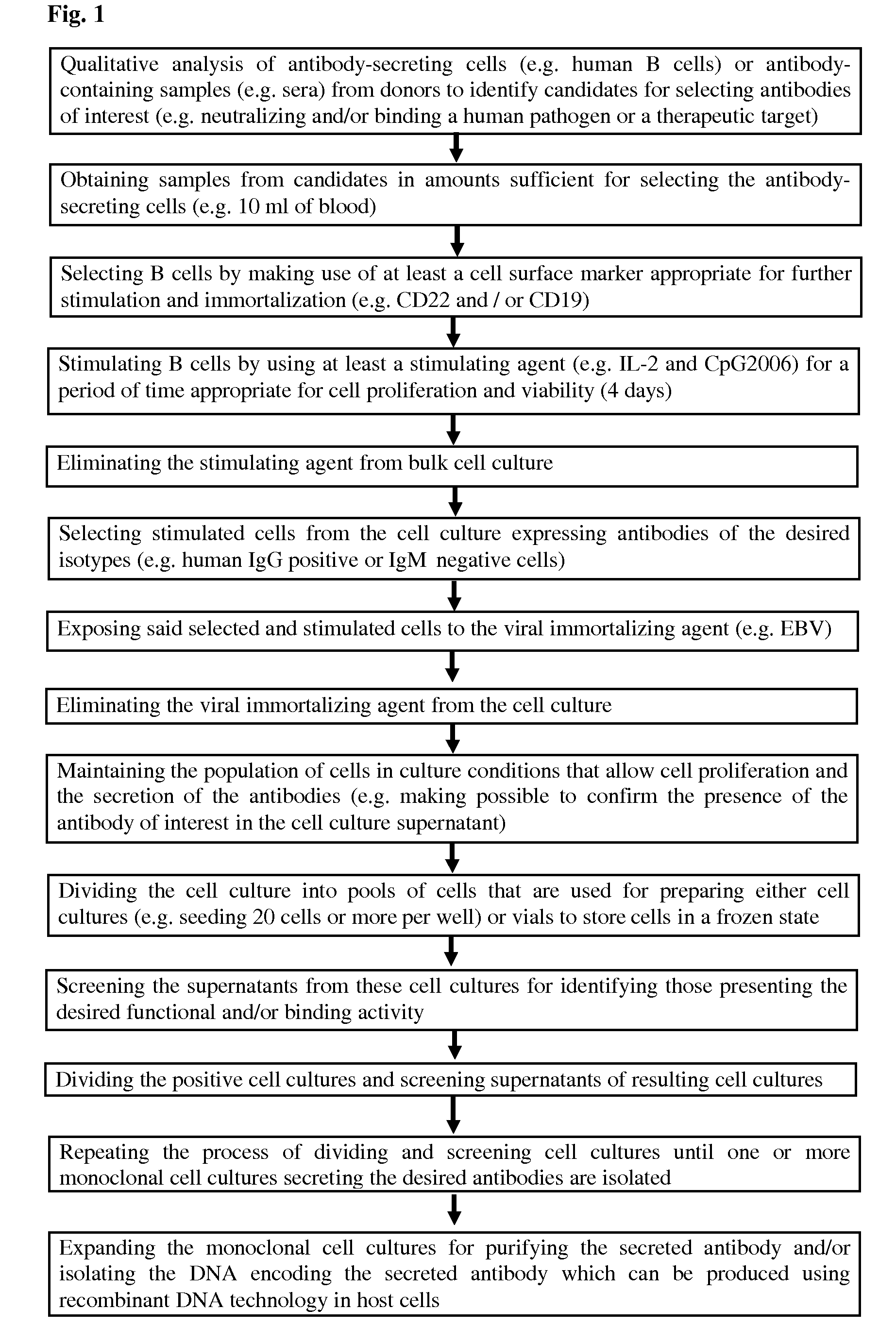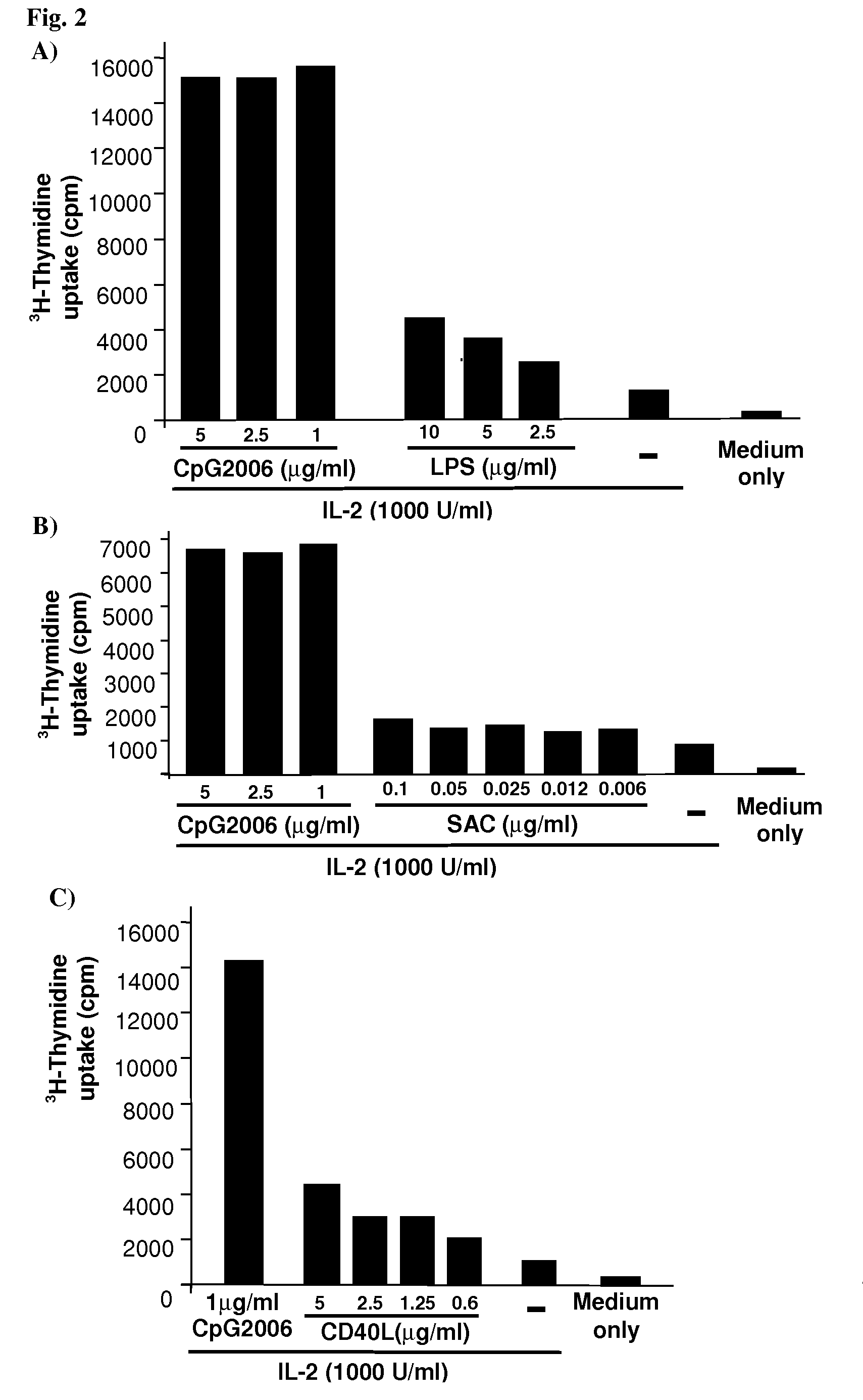Methods for obtaining immortalized antibody secreting cells
a technology of immortalized cells and secretions, which is applied in the field of methods for obtaining immortalized cells, can solve the problems of different methods of producing monoclonal antibodies fully compatible with human treatment, difficulty in propagating and maintaining natural antibody-secreting cells in culture, and different types of drawbacks
- Summary
- Abstract
- Description
- Claims
- Application Information
AI Technical Summary
Benefits of technology
Problems solved by technology
Method used
Image
Examples
example 1
Effect of Methods for Cell Purification and Stimulation on the Viability and Proliferation of B Cells in Cell Culture Conditions
Materials & Methods
Isolation and Maintenance of Human B Cells
[0223]Fresh peripheral blood mononuclear cells (PBMCs) were purified from peripheral blood by conventional density gradient centrifugation on Ficoll / Hypaque. Depending on the experiment, the cells were then processed using PBMCs from a single donor or pooled PBMCs from five different donors, in order to evaluate an average response to the different experimental conditions and to limit differences due to donors variability.
[0224]Human B cells were isolated from PBMCs by immunomagnetic cell sorting using the VarioMACS technique (Miltenyi Biotec Inc.) as described by the manufacturer. In brief, PBMCs were suspended in PBS (Phosphate-Buffered Saline) supplemented with 0.5% BSA (Bovine Serum Albumin) and 2 mM EDTA (ethylenediamine-N,N,N′,N′-tetraacetate) and incubated with different microbead-conjugate...
example 2
Effect of Methods for Cell Purification and Stimulation on the Viability Proliferation, and Antibody Secretion of B Cells Immortalized Using EBV
Materials & Methods
Selection and Analysis of B Cell Proliferation and Viability
[0246]The selection of human B cells, their stimulation, and the analysis were performed as indicated in Example 1, unless otherwise indicated.
Analysis of Surface Marker Expression by FACS
[0247]CD21 positive cells were detected by immunofluorescence and flow cytometry, using anti-CD21-PE conjugate (Caltag Laboratories, Cat. No. MHCD2104, batch 04061206), as indicated above for CD22.
Preparation of Epstein-Barr Virus (EBV) Supernatants
[0248]EBV-producing B95-8 marmoset lymphoma cells (ATCC No. CRL-1612; 5×105 / ml) were grown in RPMI-1640 cell culture medium supplemented with 10% FCS (complete medium) for 4 days.
[0249]Exponentially growing B95-8 cells were stimulated with 100 nM phorbol esters (e.g. PMA; Sigma) for 2 hours (Oh H M et al., 2003), then extensively washe...
example 3
Selection, Stimulation, Immortalization, and Screening of Human B Cells Expressing IgG Antibodies Binding or Neutralizing Therapeutic Targets
Materials & Methods
Generation of Human Immortalized B cells expressing IgG Antibodies
[0282]The overview of the procedure is provided in FIG. 11. The conditions and the means were those defined in Examples 1 and 2
CMV Microneutralisation Assay
[0283]Human embryo lung fibroblasts (HELF) are plated (2.0-2.5×104 / well) onto flat-bottom wells of a 96-well plate in 100 μl of Eagle's minimal essential medium (MEM) supplemented with 10% fetal bovine serum (FCS), 1 mM sodium pyruvate (NaP), 2 mM glutamine, 100 U / ml penicillin and 100 μg / ml streptomycin (GPS) and cultured for 24 hours at 37° C.
[0284]Fifty μl of supernatant from each B cell culture / clone are incubated with the laboratory strain CMV (AD169; 500 pfu in 50 μl of MEM with 5% FCS; total volume of the mixture is 100 μl) in round-bottom wells of a 96-well plate for 1 hour at 37° C. The medium from ...
PUM
| Property | Measurement | Unit |
|---|---|---|
| concentration | aaaaa | aaaaa |
| time | aaaaa | aaaaa |
| of time | aaaaa | aaaaa |
Abstract
Description
Claims
Application Information
 Login to View More
Login to View More - Generate Ideas
- Intellectual Property
- Life Sciences
- Materials
- Tech Scout
- Unparalleled Data Quality
- Higher Quality Content
- 60% Fewer Hallucinations
Browse by: Latest US Patents, China's latest patents, Technical Efficacy Thesaurus, Application Domain, Technology Topic, Popular Technical Reports.
© 2025 PatSnap. All rights reserved.Legal|Privacy policy|Modern Slavery Act Transparency Statement|Sitemap|About US| Contact US: help@patsnap.com



